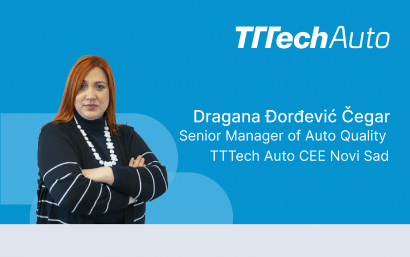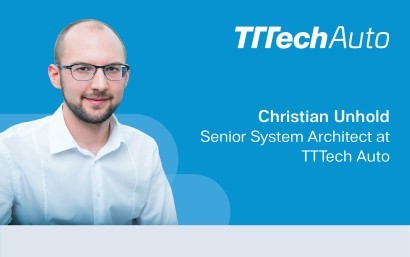Thomas Rauss is the Deputy General Manager at Technomous, the TTTech-Saic joint venture in Shanghai, China. He is responsible for developing domain controllers in modern E/E architectures and software solution excellence, as well as for growing the joint business in China and beyond. He has more than 20 years of experience in managing and executive roles and even richer life experience.
It was a real pleasure talking to Thomas and gaining his insights into the automotive evolution where safety is the top concern. We tackled ideas such as the successful implementation of autonomous solutions in China, the fundamental importance of software platforms for achieving safety and how autonomous driving can improve human lives, success, and happiness. Enjoy reading!
In your most recent positions, prior to TTTech Auto, you were responsible for strategic business growth as well as establishing new partnerships in the Asian region. Here, at TTTech Auto, you are leading the TTTech-SAIC joint venture Technomous, a company with a very successful background as Deputy General Manager. In your opinion, what know-how from your previous experiences can contribute to this company’s further growth?
I believe my previous experience has contributed significantly to my new role. Doing business in China is all about localizing and being present. One needs to engage enough with the local culture and language as well as to establish strong relationships. Being familiar with the Chinese business culture brought a better understanding of the partnerships, contracting policies and generally how to deal with these local conditions. This is naturally also very beneficial for the goals that we have at Technomous.
Based on the most recent proposal from the Ministry of Industry and Information Technology in China, local governments are being encouraged to open more roads for the testing of self-driving cars. The ministry said, "The development of autonomous driving technology in our country has entered the fast lane. The industry has a strong demand for testing cars in a real-time traffic environment”. Having this kind of governmental support is very promising, but what about the implementation of such an initiative in reality?
I have already “driven” 80 km/hour in an autonomous vehicle. In the suburbs of Shanghai, you can find stopping lots for autonomous taxis that pick you up and drive you to where you want to go. This space where they operate was previously a smaller test field, but now the entire area is covered by high-definition maps. Also, these taxis are integrated into regular traffic, there are no separate lanes for autonomous vehicles. While safety drivers are still present, they rarely engage. In China, the policy architecture is one where government decisions, local decisions for each province, and the technology providers’ decisions, happen in parallel and support initiatives. Infrastructural measures, industry engagement and necessary standards are brought forward and adjusted simultaneously. There are many examples showing that China is already very much ahead in the automation domain – In Beijings Shunyi district, online retailer packages can be delivered by autonomous delivery vehicles with a speed of up to 20km/h, autonomous robots clean streets and surveil at malls, etc. In China, the autonomous evolution is already a reality. There is an almost instant time-to-market approach.
Your background experience stretches from business development, marketing, program, and project management to strategic and financial planning. Throughout these various positions, you have had the opportunity to lead different teams and navigate them towards sustainable decisions. What is your viewpoint on the agile approach in development domain and business in general?
I think that the dynamic is there and has been for decades. I don’t think that any project has ever been delivered without any change, whether architectural or impact change. Supply chains change frequently, and it can happen only 2 months before SOP. We are very much impacted by the mobile phone industry and, as in the mobile world, the automotive industry requires continuous integration, continuous builds, and deployment. Saying that, in my experience, there are always huge changes throughout the project implementation. The dilemma that companies face is dealing with this situation and how it impacts the project. They concisely agree with the dynamics but don’t find that the traditional waterfall approach matches the requirements. Hence, the golden key is to find an agile approach that doesn’t compromise on safety and security. Although software providers already promote ”automotive agile”, I don’t see it solved innovatively yet. Smaller V model cycles/sequences are often applied, to comply with the traditional automotive development environment.
Whichever business model we choose, it is crucial that we never compromise on ensuring safety. Unlike with mobiles, in critical functions related to driving, exposing somebody to full dependency on a machine, we cannot let users find bugs that we fix afterwards.
In the long list of your professional and personal achievements, most of them were in some way linked to technology. However, there were two very different aspects that are interesting. From 2001-2004, you lead a company in Africa, and from 2008-2012, you worked in India. How have these experiences enriched you as a person you are today?
From my standpoint, you continuously pose questions to yourself. You don’t assume that the way you perceive things is automatically right. Whether in India, Africa, China, or Germany, everyday customs look completely different and one needs to adjust to the environment as much as possible to understand the processes and people around them. This is important for overall successful functioning, both professionally and privately. Again, localization is crucial here.
I would also say that you learn how to value things you had back home more when being exposed to different cultures, landscapes, and standards of living in general. To be truly happy, you don’t need much. Sometimes, one child's smile caught on the way to the high-tech park in India was enough to highlight my day. That makes you realize that something so simple as a smile is the essence of what we really need through life. And since it’s not depending on big prerequisites, it is a reliable source of energy for whatever you do.
During this part of your life, you were contributing to the sustainable development in Africa through different aspects. In doing this, it seems like you motivated the local people to be more active in their communities and also in their environment through working with, and winning over, the local small businesses and people. Along these lines, earning trust and providing solutions for the concerns of the people is key. The same is true if it comes to safety of the people involved in our activities and earning their trust. Trust and acceptance are important considerations in the autonomous driving domain. In your opinion, what are the prerequisites for the continuous growth of automated driving technologies, in terms of safety and public acceptance?
First, generalization and standardization are the key. Think of a nice villa compound. The villas are the vehicle brands, differentiated by size, style, market segment etc. Under each individual villa sits the reason why you were able to build your nice home, allowing you to sip your coffee on your terrace in peace - the rock-solid foundation. If the foundation is bad, the entire system will collapse, and the overall safety is compromised. Therefore, the most important development teams do the “ugly” work of a foundation. This foundation, the SW platform, doesn’t need to be done differently for different customers. It has nothing to do with the design or beauty, it is not even visible to the customer, but is a prerequisite for safe autonomous driving. The sound, clear platform is of vital interest to everybody. It doesn’t differentiate between the OEM brands but allows them to individualize.
Second, general safety is an immanent need of any living being. And this holds especially true when exposed to a situation where you have to give yourself into being commuted by a machine. A recent Deloitte China market study stated that the buying decision for a new vehicle is mainly based on safety, in a country where entertainment and infotainment capabilities are highly appreciated. The willingness to spend more than 500 dollars for a feature in the car is dominated by driver assistance functions such as auto emergency braking or lane departure warning and not by the IVI. Generally, the awareness of safety is increasing and without this, the entire ecosystem would be endangered and doesn’t work. Safety isn’t something that can be compromised on by different features in the car. People expect safety for themselves and their families to be an undebatable foundation, regardless of the chosen vehicle brand, which makes it a generally obligatory standard. We should all come together in achieving the same understanding of safe autonomous driving and take joint steps towards this goal. A great example of this kind of initiative is The Autonomous.
In your opinion, what would be the main impact of fully autonomous cars on society in general?
We are usually talking about urban areas, aspects of being connected, means of city transport, about cities without pollution. However, we should not forget the countryside as we want to avoid too many people moving to cities and contributing to the congestion.
67% of the Chinese population still lives in Tier 3-5 cities, that excludes the 35 biggest cities and accounts for almost a billion people.
In China, as in Europe, we have aging societies that live in rural areas and cannot commute efficiently enough, which significantly decreases their life quality. We need to help this population equally to maintain and continuously improve living standards, wherever they live. China is a role model for driving initiatives to emphasize infrastructural investment outside of the established megacities. Autonomous driving, including the commercial vehicle sector, is one of the vital pieces for providing attractive living conditions beyond the biggest agglomerations, and will help stop the rural exodus.
Generally, we need to be aware that autonomous driving is always driven by some regulation or broader trends. No OEM intrinsically decided to produce autonomous vehicles. In the context of smart, connected mobility, it means producing fewer vehicles. Connected mobility is a threat to established OEMs. The automobile industry is now driven by this, after having spent the last 100 years behind the steering wheel. That’s a big impact.
The most valid driver for engaging more autonomous vehicles is environmental. Carbon footprint awareness and climate change impacts should be the strong enough argument to make us push harder towards a contextual, fully automated driving reality.
Car manufacturers are challenged to reinvent themselves, accepting an interdependent position with complex business models as part of the emerging smart mobility ecosystem and an awareness for the greater good of society, the planet.
Accelerate your journey towards highly automated driving with MotionWise safety software platform. MotionWise delivers safety by design and fail-operational performance while managing the high complexity of solution elements. As a result, OEMs and Tier 1 suppliers can benefit from faster time-to-market for their automated driving projects and increased competitive edge at reduced costs. Stay informed about the most recent technological findings in the automotive industry - visit us at www.tttech-auto.com and follow us on LinkedIn for more on this exciting topic.
Related Insights



